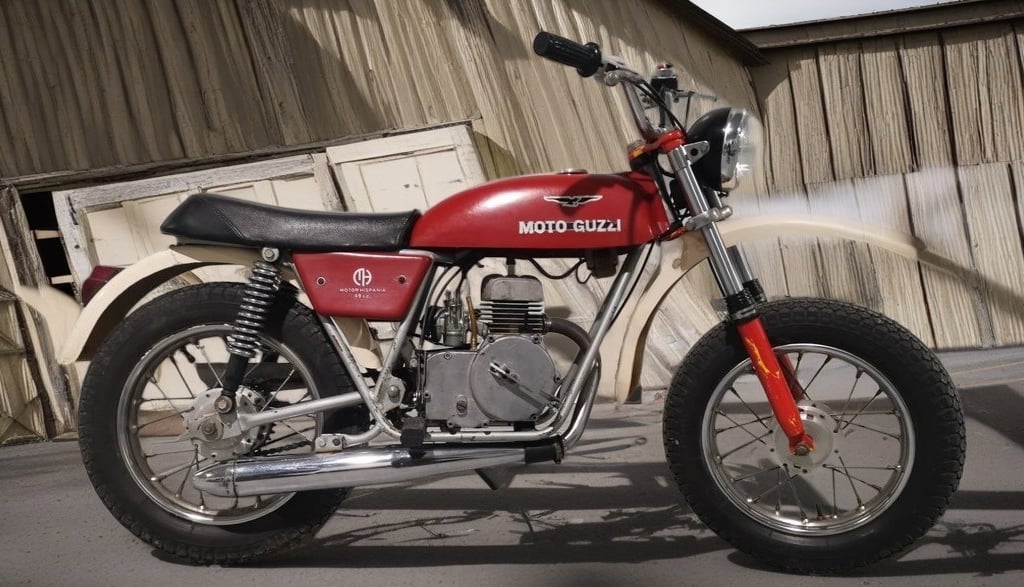The Trailblazing 1975 Moto Guzzi Hispania Pony Off-Road Moped: A Legacy Revisited
The article revisits the legacy of the 1975 Moto Guzzi Hispania Pony, an off-road moped known for its innovation, design, and contribution to off-road moped culture.
MOTO GUZZIITALY TWO STROKE1970'SCLASSIC MOPEDSOFF ROAD MOPEDS
5/3/20243 min read


The Trailblazing 1975 Moto Guzzi Hispania Pony Off-Road Moped: A Legacy Revisited
Introduction
The 1975 Moto Guzzi Hispania Pony stands as a beacon of innovation within the off-road moped segment, highlighting Moto Guzzi’s daring exploration into the realm of lightweight, rugged motorcycles designed for the road less traveled. This piece revisits the legacy of a model that, though less known in the mainstream moped narrative, carved out a niche for enthusiasts seeking adventure beyond paved roads. With its unique blend of Moto Guzzi's Italian craftsmanship and a design tailored for off-road resilience, the Pony exemplified the spirit of exploration and freedom that defined the era.
History and Creation
In the 1970s, the motorcycle industry began to diversify its offerings, catering to a wider array of riding preferences and environments. This period saw the rise of specialized models designed for performance in specific settings, from sleek racers to bulky tourers. Amid this panorama of innovation, the 1975 Moto Guzzi Hispania Pony emerged as Moto Guzzi's ambitious venture into the thriving off-road moped sector. Crafted during a time when the thirst for adventure riding was gaining momentum, the Pony was Moto Guzzi’s answer to riders' call for a moped that could tackle both the urban commute and the challenges of the rugged trails.
Design and Specifications
At the heart of the 1975 Moto Guzzi Hispania Pony’s design was its blend of functionality and simplicity, engineered to navigate the unpredictable terrains of off-road paths. The moped was powered by a 50cc two-stroke engine, a modest powerhouse that provided a balance between efficiency and the necessary torque for off-road adventures. Notably, it featured a 3-speed transmission operated via a handlebar-mounted lever, akin to the system found in Vespa models, and boasted a centrifugal clutch, simplifying the riding process by eliminating the need for manual clutch engagement during gear changes.
The Pony’s rugged appearance was matched by its durable construction, designed to withstand the trials of off-road riding. The basic yet effective suspension system ensured a smoother ride over rough terrains, while its lightweight frame enhanced maneuverability and ease of control. These design characteristics not only made the Pony a reliable companion for off-road enthusiasts but also marked it as a distinctive entry in the off-road moped category, differentiating it from its contemporaries with its unique blend of Italian design sensibility and functional off-road prowess.
Performance and Riding Experience
The agility and robustness of the Moto Guzzi Hispania Pony made it a compelling choice for riders eager to venture off the beaten path. Its 50cc engine, while not the most powerful, was tuned to deliver a steady supply of torque essential for navigating rough terrains. Coupled with the ease-of-use offered by its Vespa-like gear system and centrifugal clutch, the Pony provided a riding experience that was both exhilarating and accessible to riders of various skill levels.
The moped’s off-road capabilities were further accentuated by its suspension system and lightweight construction, allowing for responsive handling and a degree of agility uncommon in mopeds of that era. Riders could tackle dirt trails and uneven surfaces with confidence, enjoying a sense of adventure that only off-road riding could offer. This blend of performance, simplicity, and reliability underpinned the Pony’s appeal as an off-road moped, offering a unique riding experience that was both challenging and rewarding.
Cultural and Market Impact
While not as widely recognized as some of its contemporaries, the 1975 Moto Guzzi Hispania Pony has quietly cultivated a dedicated following within the moped community, particularly among aficionados of off-road riding. Its unique position as a rugged, off-road capable moped has made it a sought-after piece for those interested in the niche of adventure mopeding. The Pony’s contribution to off-road moped culture is notable, providing a bridge between traditional mopeds and the burgeoning world of all-terrain vehicles.
Today, the Moto Guzzi Hispania Pony is celebrated for its rarity and the innovation it represented during its time. Its scarcity on the market, compounded by its distinctive features and Moto Guzzi’s reputable craftsmanship, has elevated the Pony’s desirability among collectors. It stands as a prized possession for vintage motorcycle enthusiasts, a tangible piece of Moto Guzzi’s adventurous spirit, and a testament to a time when the boundaries of moped utility and versatility were being expanded.
Conclusion
The 1975 Moto Guzzi Hispania Pony off-road moped stands as an emblematic figure in the history of two-wheeled adventure. Far more than a mere mode of transportation, it symbolized a departure from convention, an invitation to explore the unknown. Its distinct blend of Italian engineering and off-road capability has ensured that the Pony remains not just a memory, but a valued piece of motorcycling heritage.
For collectors and vintage motorcycle enthusiasts, the Pony is not only a rare find but a cherished relic of a bygone era of exploration and freedom. Its enduring legacy is a reminder of the roads less traveled and the adventures that lie beyond the horizon.
